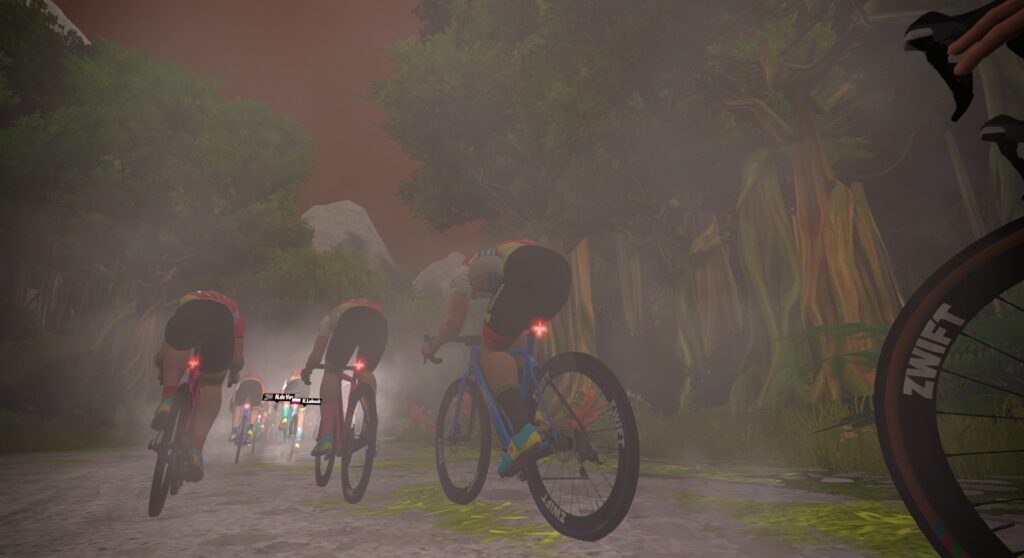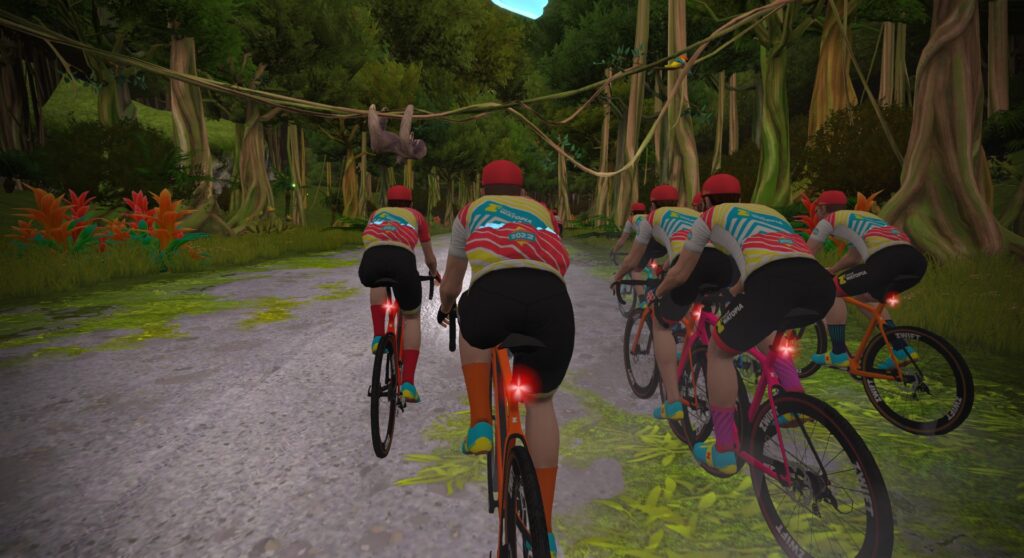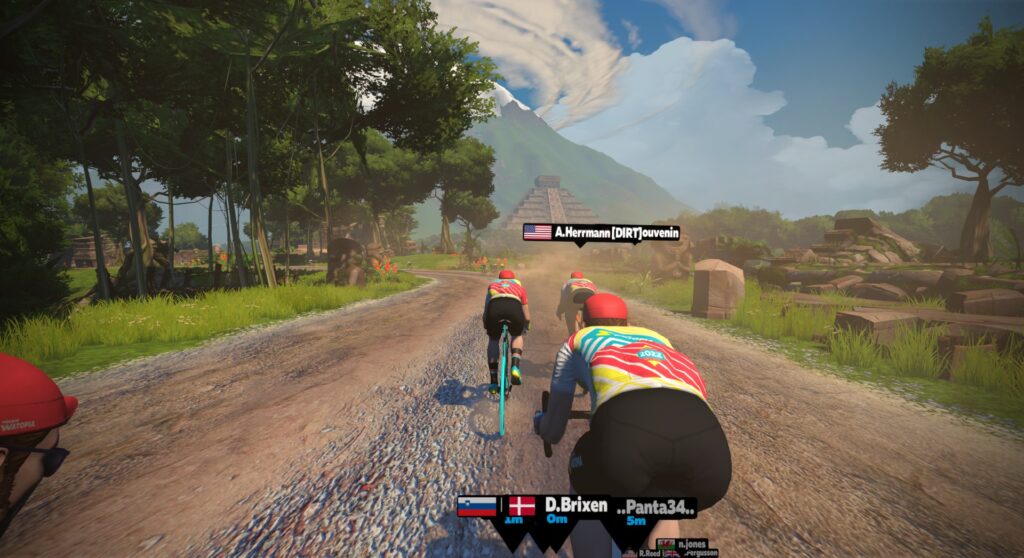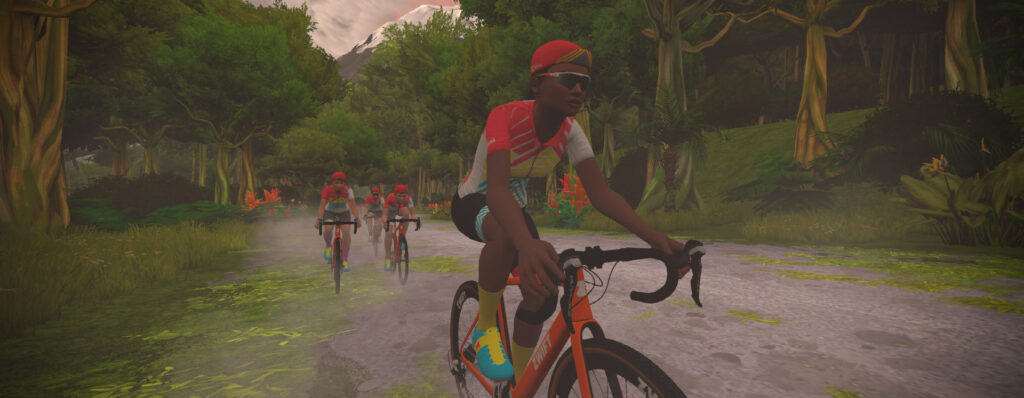Observant Zwifters riding Stage 4 of Tour of Watopia this week may notice subtle changes to the Jungle’s dirt roads. Here’s are some screenshots:



Do you see the difference? The ToW surface (we’ll just call it “gravel”) is a greyish color instead of red/brown, and the gravel is more grown over with green plants.
Some riders felt the new gravel was dustier than the standard Jungle dirt, but we’re not sure this is the case – we think there’s just a lot of dust because there are a lot of riders in the ToW events.
New ToW Gravel:
Standard Jungle Dirt:
New Surface Is Big News
If you free ride or do a non-ToW event in the Jungle today, you’ll be riding on the standard Jungle dirt. But if you ride in the Jungle during a ToW Stage 4 event, that dirt magically transforms to the new gravel surface.
As far as we know, this is the first time Zwift has rolled out a new surface for a specific event. Presumably, this is a programmatic surface swap – that is, both types of surfaces are defined game-wide in terms of Crr, sounds, and visuals, and every bit of “path” in Zwift’s worlds has a default surface type. For this event, a custom setup flag was set, effectively saying “If surface type = dirt, swap it for gravel”.
This is an interesting development. Let’s consider what it could lead to:
- Just having a “gravel” surface type makes sense – it’s something Zwifters have been pushing for for a long time. There should be gravel roads on Zwift where gravel bikes outperform MTB, then rougher roads (perhaps only singletrack trails?) where MTB outperform gravel bikes. Maybe this is a step in that direction.
- Events with custom road types: the Jungle could be paved. A cobbled climb up Alpe du Zwift. Swap all dirt on a route for pavement… and swap pavement for dirt! Or a super fast glass road for a Tempus Fugit TT.
- Swapping surface types could change the very nature of many routes on Zwift, creating attack points where none existed before.
- If surface types change, so does rolling resistance. Not a huge deal if you put in a surface type with higher Crr, but if you use a lower Crr riders will be setting PR times on courses which they can never beat.
The Big Difference: Lower Crr
While the gravel is visually different from the standard dirt, perhaps the biggest difference is one you can’t easily spot. The new gravel surface has lower rolling resistance (Crr) than the standard dirt.
The stock Zwift Gravel wheels (which everyone uses for ToW Stage 4) have a Crr of .018 in the standard dirt. But on this new gravel surface, their Crr is .012! That’s a significant reduction in resistance which is noticeable in terms of how much power it takes to hold a particular speed on course.
By our calculations, a solo rider holding 40kph on standard Jungle dirt would be putting 147W into overcoming rolling resistance. But when the Crr is lowered to .012, the same rider only needs to put in 98W to overcome rolling resistance.

No Bike Choice? No Big Deal.
For Stage 4, Zwift is placing everyone on the stock Zwift Gravel frame and wheelset. Some Zwifters have complained about this, because they wanted to use the “faster” new gravel wheelsets which Zwift recently released (read about those here and here).
But here’s the thing: we don’t actually know if those new wheelsets would be faster on the new gravel surface or not! Remember, they roll faster on dirt (.016 Crr vs the standard .018). But if they roll at .016 on the new gravel surface, that would make them significantly slower than the stock Zwift Gravel wheels which roll at .012.
So don’t sweat the bike choice thing. Everyone’s on the same setup, and the new gravel surface makes for a faster trip around the Handful of Gravel route than you could have with any other setup. Get dirty, and have fun!
Questions or Comments?
Share below!

